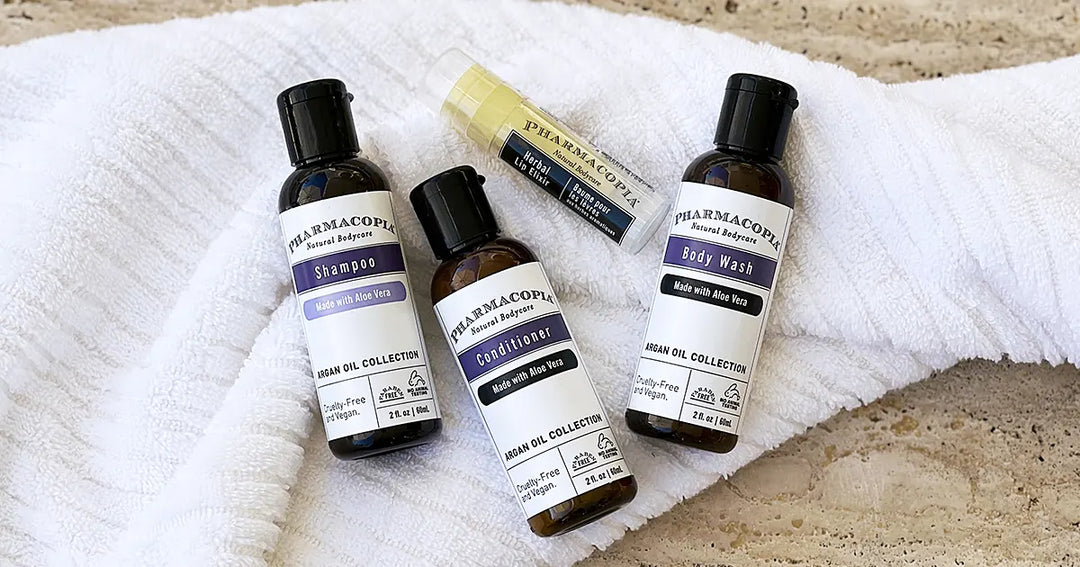Do Shampoos and Conditioners Expire?
We all know that food expires, but most of us don’t think of how important expiration dates are when it comes to our body care products. All personal care items, including Pharmacopia skin care, shampoos, and conditioners, have an expiration date—particularly after they’ve been opened.
 Why Do Shampoos and Conditioners Expire?
Why Do Shampoos and Conditioners Expire?
Shampoos and conditioners combine water with a mix of ingredients that provide a friendly environment for bacteria to grow. (Bacteria love anything with water, needing it to survive.) This is why all personal care products that have water need a preservative to prevent bacterial growth. Preservatives like potassium sorbate, phenoxyethanol, and benzoic acid do help extend the shelf life of a product, but they can’t extend it forever. Preservatives do wear off over time and products degrade depending on the conditions in which they’re stored. That old saying that nothing lasts forever is true when it comes to personal care products. (Read more on Pharmacopia preservatives)
Additionally, these products are typically stored in a bathroom or shower with high humidity, where bacteria thrive. Every time we open a product to use it, there’s a chance that water or bacteria can end up in the product, moving it quickly towards the end of its shelf life.
Can You Use Expired Shampoo or Expired Conditioner?
Yes. Keep in mind that the expiration of personal care products won’t make you sick like expired food can. Expired products can, however, irritate the skin and/or scalp, particularly if you have sensitive skin, not working in the way they normally should. What this means for a shampoo is that it may not get your hair as clean as you’d like, and for a conditioner, it may leave your hair looking dull.
How to Know When My Shampoo and Conditioner Expires
Unlike food products, the Food and Drug Administration (FDA) doesn’t require personal care products like shampoos and conditioners to list an expiration date. However, every Pharmacopia product—and most other personal care products—has something called a “Period After Opening” suggestion. This is indicated by a tiny symbol on the product label. In the case of Pharmacopia products, this symbol—which looks like an open container with either 6M, 12M, 18M, or 24M on it—is located right by our recycling symbol and our cruelty free symbol. This indicates how long a product is good after opening. We recommend 12 months after opening for our shampoos and conditioners.

6M = product lasts 6 months after opening it
12M = product lasts 12 months after opening it
18M = product lasts 18 months after opening it
24M = product lasts 24 months after opening it
If a product hasn’t been opened, it can last two to four years if stored in a cool cupboard or closet away from humidity. (Heat, whether it be from indoor heat, hot water, or direct sunlight, can cause a product to expire more quickly, which is why you don’t want to store products in a bathroom or car.) Remember, opening a container exposes it to air, dirt, water, and possible bacteria growth, so try to avoid opening a product to smell it or try it if you know that you won’t be using it for a while.
But what if you can’t remember how long you’ve had a product or when you bought it? This is when you need to be the judge. If a product smells good and the consistency is good, then it’s most likely still okay to use. If there’s been any change in the product, it may be time to toss it.
What to Look for in an Expired Shampoo or Conditioner
Maybe you’ve had a product for a long time, and it doesn’t perform as well as it used to. Or it smells different (bad) from when it was first opened. These may be signs that your shampoo or conditioner has expired. It’s important to note that since we use all-natural essential oils, these oils—which give all our Pharmacopia products amazing scents—tend to dissipate more quickly than synthetic fragrances. This means that after opening, our scent may lose its potency over time, but if it feels good and works well, it's still okay to use.
Here are other things to look for in a product that you’re not sure how long you’ve had:
- The color has changed. Instead of being white or cream, a shampoo and/or conditioner, for example, may become yellowish. This is usually one of the most obvious ways, besides smell, of figuring out when a shampoo and/or conditioner has to be replaced.
- There’s separation occurring in the product. If a shampoo or conditioner, for example, contains oils and water (as most do), you may find an oil sitting at the top of the product when you open it. This alone may not be a reason to toss, but when combined with the other characteristics listed here, it may be time to replace it.
- The consistency has changed. Instead of being smooth and creamy, a conditioner might become lumpy. This is a good sign that your shampoo or conditioner has expired.
How to Extend the Life of Your Shampoo and Conditioner
There are certain things you can do to ensure that your products last as long as possible. These include:
- Store away from heat and direct sunlight. Heat (i.e., from a warm bathroom or storing a product in direct sunlight) can cause a product to break down more quickly. A cool, dry, dark cupboard is usually the best place to store personal care products you’re not using.
- Use a pump. Not only are pumps more efficient, using them also allows for less air to get into the product. The more air that gets in, the faster that product will degrade. Pumps also prevent water from getting into the product; extra water in a product can cause bacteria to grow.
- If you open a lid, make sure you close it completely. Air, water, and moisture can easily get into a product through a lid that’s not quite closed. If you keep your shampoo and conditioner in the shower, as most of us do, this becomes very important as you don’t want to contaminate a product.
If a product looks or smells past its prime and you decide to replace it, remember not to just toss it. Rinse the product down the drain and clean out the container before recycling it.


